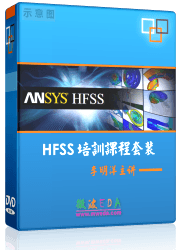Choose the Driven Modal solution type when you want HFSS to calculate the modal-based S-parameters of passive, high-frequency structures such as microstrips, waveguides, and transmission lines. The S-matrix solutions will be expressed in terms of the incident and reflected powers of waveguide modes.
Driven Terminal Solution
Choose the Driven Terminal solution type when you want HFSS to calculate the terminal-based S-parameters of multi-conductor transmission line ports. The S-matrix solutions will be expressed in terms of terminal voltages and currents.
Eigenmode Solution
Choose the Eigenmode solution type to calculate the eigenmodes, or resonances, of a structure. The Eigenmode solver finds the resonant frequencies of the structure and the fields at those resonant frequencies.
关于driven modal与driven terminal的理解
1.driven modal模式驱动,所谓模式驱动就是hfss根据用户所定义的模式数目求解端口模式数目及场分布,并为每个模式分配相等的功率,仿真时用端口场分布做为边界条件对内部进行求解,默认端口阻抗为Zpi无须定义积分线来求解电压, S参量用入射反射功率来表示
2.对于分析偶合传输线等一个端口上有多个终端,而求解终端之间偶合问题的模型,driven modal是不适合的.应用driven terminal ,这里以微带偶合传输线为例子说明这个问题
在这个端口上tem波有两种模式1.偶模:V1=V22.奇模. V1=-V2(V1为导体1对接地板等效电压, V2为导体2对接地板等效电压)如果用driven modal求结则这两种模式分别被赋予相等功率,而求解出的S11则是整个端口上的每一种模式的反射情况,而不能直接求出两线的偶合状况(例如只激励导体1,求导体2上的端口电压)这显然是不合适的.
(关于偶合传输线问题详情见microwave engineeringedition 37.6节)
Driven terminal默认的求解终端阻抗为Zvi故对于每个终端需要定义积分线,例如上图中terminal的积分线为从接地版到导体1的连线(导体1,接地版都为等势体,路径没有关系),terminal2的积分线为接地版到导体2)计算机求解时对两个终端分别进行激励,通过电压与电流来计算他们之间的偶合关系.
3总结
1.如果模型中有类似于偶合传输线求偶合问题的模型一定要用driven terminal求解,
2.driven modal适于其他模型,但一般tem模式(同轴,微带等)传输的单终端模型一般用driven terminal分析(tem波电压一般由两导体之间电场积分定义,电流为环线磁场的积分,阻抗Zvi=Zpi=Zpv区别于TE TM)由于其直接对电流电压求解而避免了对整个面上功率的计算从而比较简便.
hfss好用,但比较耗资源啊
了解多了,推!
谢谢你,辛苦了.
清楚详细,多谢楼主
理不辩不明,谢谢了
???
声明:网友回复良莠不齐,仅供参考。如需更专业、系统的学习HFSS,可以购买本站资深专家讲授的HFSS视频培训课程。


